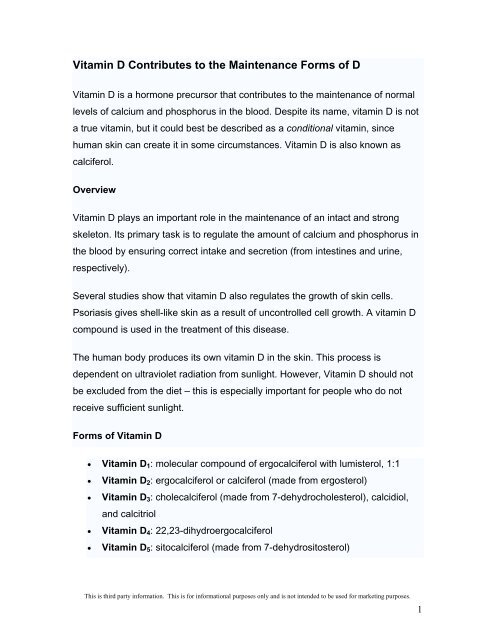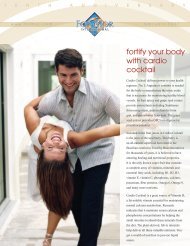Vitamin D is a hormone precursor that contributes - Formor.com formor
Vitamin D is a hormone precursor that contributes - Formor.com formor
Vitamin D is a hormone precursor that contributes - Formor.com formor
You also want an ePaper? Increase the reach of your titles
YUMPU automatically turns print PDFs into web optimized ePapers that Google loves.
<strong>Vitamin</strong> D Contributes to the Maintenance Forms of D<br />
<strong>Vitamin</strong> D <strong>is</strong> a <strong>hormone</strong> <strong>precursor</strong> <strong>that</strong> <strong>contributes</strong> to the maintenance of normal<br />
levels of calcium and phosphorus in the blood. Despite its name, vitamin D <strong>is</strong> not<br />
a true vitamin, but it could best be described as a conditional vitamin, since<br />
human skin can create it in some circumstances. <strong>Vitamin</strong> D <strong>is</strong> also known as<br />
calciferol.<br />
Overview<br />
<strong>Vitamin</strong> D plays an important role in the maintenance of an intact and strong<br />
skeleton. Its primary task <strong>is</strong> to regulate the amount of calcium and phosphorus in<br />
the blood by ensuring correct intake and secretion (from intestines and urine,<br />
respectively).<br />
Several studies show <strong>that</strong> vitamin D also regulates the growth of skin cells.<br />
Psorias<strong>is</strong> gives shell-like skin as a result of uncontrolled cell growth. A vitamin D<br />
<strong>com</strong>pound <strong>is</strong> used in the treatment of th<strong>is</strong> d<strong>is</strong>ease.<br />
The human body produces its own vitamin D in the skin. Th<strong>is</strong> process <strong>is</strong><br />
dependent on ultraviolet radiation from sunlight. However, <strong>Vitamin</strong> D should not<br />
be excluded from the diet – th<strong>is</strong> <strong>is</strong> especially important for people who do not<br />
receive sufficient sunlight.<br />
Forms of <strong>Vitamin</strong> D<br />
• <strong>Vitamin</strong> D1: molecular <strong>com</strong>pound of ergocalciferol with lum<strong>is</strong>terol, 1:1<br />
• <strong>Vitamin</strong> D2: ergocalciferol or calciferol (made from ergosterol)<br />
• <strong>Vitamin</strong> D3: cholecalciferol (made from 7-dehydrocholesterol), calcidiol,<br />
and calcitriol<br />
• <strong>Vitamin</strong> D4: 22,23-dihydroergocalciferol<br />
• <strong>Vitamin</strong> D5: sitocalciferol (made from 7-dehydrositosterol)<br />
Th<strong>is</strong> <strong>is</strong> third party information. Th<strong>is</strong> <strong>is</strong> for informational purposes only and <strong>is</strong> not intended to be used for marketing purposes.<br />
1
<strong>Vitamin</strong> D3, also known as cholecalciferol, <strong>is</strong> a form of vitamin D <strong>that</strong> <strong>is</strong> made by<br />
the human body. It <strong>is</strong> made in the skin when 7-dehydrocholesterol reacts with<br />
UVB ultraviolet light with wavelengths 290 to 315 nm. Th<strong>is</strong> can be found in<br />
sunlight when the sun <strong>is</strong> high enough above the horizon for UVB to penetrate the<br />
atmosphere and <strong>is</strong> responsible for the production of cholecalciferol. Up to 20,000<br />
IU can be made in the skin only after one minimal erythemal dose of exposure, or<br />
until the skin just begins to turn pink.<br />
<strong>Vitamin</strong> D2 <strong>is</strong> derived by irradiating fungi to produce ergocalciferol. Ergocalciferol<br />
does not naturally occur in the human body unless it <strong>is</strong> added by<br />
supplementation. In the rat, D2 <strong>is</strong> more effective as a vitamin than D3, and in the<br />
squirrel monkey and the chick, D3 <strong>is</strong> more effective [1] . In humans, D3 <strong>is</strong> more<br />
effective than D2 at increasing 25-hydroxyvitamin D, the circulating reservoir of<br />
the vitamin D <strong>hormone</strong>. In certain parts of the world, particularly at higher<br />
latitudes, total vitamin D input <strong>is</strong> usually not sufficient, especially in the winter,<br />
thus the recent concern about widespread vitamin D deficiency. To help prevent<br />
th<strong>is</strong>, foods such as milk may be fortified with vitamin D2 or vitamin D3, typically<br />
giving 100 IU per glass. Cholecalciferol <strong>is</strong> transported to the liver where it <strong>is</strong><br />
hydroxylated to calcidiol or 25-hydroxy-vitamin D, the form of the vitamin <strong>that</strong> the<br />
body stores. A blood calcidiol level <strong>is</strong> the only way to determine vitamin D<br />
deficiency; levels should be between 40 and 60 ng/mL (100 to 150 nMol/L) for<br />
optimal health. The most active form of the vitamin <strong>is</strong> calcitriol (1,25 dihydroxy<br />
vitamin D3), a potent <strong>hormone</strong>. Calcitriol <strong>is</strong> synthesized from calcidiol in the<br />
kidneys to perform its endocrine function of maintaining the calcium economy.<br />
Calcitriol binds to a transcription factor which then regulates gene expression of<br />
transport proteins like TRPV6 and calbindin <strong>that</strong> are involved in calcium<br />
absorption in the intestine. The general result <strong>is</strong> the maintenance of calcium and<br />
phosphorus levels in the bone and blood with the ass<strong>is</strong>tance of parathyroid<br />
<strong>hormone</strong> and calcitonin. A number of t<strong>is</strong>sues throughout the human body also<br />
have the ability to make and regulate their own calcitriol. It <strong>is</strong> these autocrine and<br />
Th<strong>is</strong> <strong>is</strong> third party information. Th<strong>is</strong> <strong>is</strong> for informational purposes only and <strong>is</strong> not intended to be used for marketing purposes.<br />
2
paracrine functions of the vitamin D system <strong>that</strong> may explain its association with<br />
a host of chronic d<strong>is</strong>eases.<br />
<strong>Vitamin</strong> D food sources<br />
Fortified foods are the major dietary sources of vitamin D. Prior to the fortification<br />
of milk products with vitamin D in the 1930s, rickets, <strong>com</strong>monly caused by<br />
vitamin D deficiency, was a major public health problem. In the United States<br />
milk <strong>is</strong> fortified with 10 micrograms (400 IU) of vitamin D per quart, and rickets <strong>is</strong><br />
now un<strong>com</strong>mon there.<br />
One cup of vitamin D fortified milk supplies about one-fourth of the official<br />
estimated adequate intake of vitamin for adults older than age 50 years. Although<br />
milk <strong>is</strong> often fortified with vitamin D, dairy products made from milk (cheese,<br />
yogurt, ice cream, etc.) are generally not. Only a few foods naturally contain<br />
significant amounts of vitamin D, including: [2]<br />
• F<strong>is</strong>h liver oils, such as cod liver oil, 1 Tbs. (15 ml), 1,360 IU (340% Daily<br />
value)<br />
• Fatty f<strong>is</strong>h, such as:<br />
o Salmon, cooked, 3.5 oz, 360 IU (90% DV)<br />
o Mackerel, cooked, 3.5 oz, 345 IU (90% DV)<br />
o Sardines, canned in oil, drained, 1.75 oz, 250 IU (70% DV)<br />
o Tuna, canned in oil, 3 oz, 200 IU (50% DV)<br />
o Eel, cooked, 3.5 oz, 200 IU<br />
• One whole egg, 20 IU (6% DV)<br />
<strong>Vitamin</strong> D <strong>is</strong> <strong>com</strong>monly measured in micrograms (mcg). However, International<br />
Units (IU) <strong>is</strong> the unit of measurement for vitamin D <strong>that</strong> appears on food labels.<br />
Nutrition<br />
Th<strong>is</strong> <strong>is</strong> third party information. Th<strong>is</strong> <strong>is</strong> for informational purposes only and <strong>is</strong> not intended to be used for marketing purposes.<br />
3
The U.S. Dietary Reference Intake (DRI) for an Adequate Intake (AI) for a 25-<br />
year old male for <strong>Vitamin</strong> D <strong>is</strong> 5 micrograms/day (200 units/day). Th<strong>is</strong> r<strong>is</strong>es to 15<br />
micrograms/day (600 units/day) at 70. [3]<br />
D<strong>is</strong>eases caused by deficiency<br />
<strong>Vitamin</strong> D deficiency <strong>is</strong> known to cause several bone d<strong>is</strong>eases, due to insufficient<br />
calcium or phosphate in the bones:<br />
• Rickets: a childhood d<strong>is</strong>ease characterized by failure of growth and<br />
deformity of long bones.<br />
• Osteoporos<strong>is</strong>: a condition characterized by fragile bones.<br />
• Osteomalacia: a bone-thinning d<strong>is</strong>order in adults <strong>that</strong> <strong>is</strong> character<strong>is</strong>ed by<br />
proximal muscle weakness and bone fragility. Osteomalacia can only<br />
occur in a mature skeleton.<br />
Pioneering work in <strong>is</strong>olating vitamin D and determining its role in rickets was<br />
done by Edward Mellanby in 1918-1920. <strong>Vitamin</strong> D deficiency <strong>is</strong> endemic in dark<br />
skinned races living in high latitudes (see below).<br />
<strong>Vitamin</strong> D malnutrition may possibly be linked to chronic d<strong>is</strong>eases such as cancer<br />
(breast, ovarian, colon, prostate, lung and skin and probably a dozen more<br />
types), chronic pain, weakness, chronic fatigue, autoimmune d<strong>is</strong>eases like<br />
multiple scleros<strong>is</strong> and Type 1 diabetes, high blood pressure, mental illnesses<br />
(depression, seasonal affective d<strong>is</strong>order and possibly schizophrenia) heart<br />
d<strong>is</strong>ease, rheumatoid arthrit<strong>is</strong>, psorias<strong>is</strong>, tuberculos<strong>is</strong>, periodontal d<strong>is</strong>ease and<br />
inflammatory bowel d<strong>is</strong>ease. [4]<br />
Who may need extra vitamin D to prevent a deficiency<br />
Older people (age 50 and over) have a higher r<strong>is</strong>k of developing vitamin D<br />
deficiency. The ability of skin to convert 7-dehydrocholesterol to pre-vitamin D3 <strong>is</strong><br />
decreased in older people. The kidneys, which help convert calcidiol to its active<br />
Th<strong>is</strong> <strong>is</strong> third party information. Th<strong>is</strong> <strong>is</strong> for informational purposes only and <strong>is</strong> not intended to be used for marketing purposes.<br />
4
form, sometimes do not work as well when people age. Therefore, many older<br />
people may need vitamin D supplementation.<br />
Newborn infants who are exclusively breastfed may require vitamin D<br />
supplements. Breast milk does not contain significant levels of the vitamin, and<br />
although infants could receive th<strong>is</strong> vitamin from sunlight, it <strong>is</strong> usually not<br />
re<strong>com</strong>mended <strong>that</strong> small infants be exposed to sunlight in the levels required to<br />
produce a sufficient amount of vitamin D. Infant formula <strong>is</strong> generally fortified with<br />
vitamin D, so th<strong>is</strong> requirement only applies to breastfed infants.<br />
Dark-skinned people living at higher latitudes may require extra <strong>Vitamin</strong> D<br />
because their high level of skin pigmentation generally retards the absorption of<br />
UV rays. Th<strong>is</strong> does not pose a problem in tropical areas, where the amount of<br />
sunshine <strong>is</strong> so high <strong>that</strong> enough <strong>Vitamin</strong> D <strong>is</strong> produced despite the dark skin<br />
color. At higher latitudes, however, the decreased angle of the sun's rays,<br />
reduced daylight hours in winter, and protective clothing worn to guard against<br />
cold weather prove detrimental to the absorption of sunlight and the production of<br />
<strong>Vitamin</strong> D. Light-skinned people at higher latitudes also face these problems, but<br />
the lower amount of pigmentation in their skin allows more sunlight to be<br />
absorbed, thereby reducing the r<strong>is</strong>k of <strong>Vitamin</strong> D deficiency (conversely, light-<br />
skinned people are d<strong>is</strong>advantaged in the tropics, as they are more susceptible<br />
than dark-skinned people to intense sunlight and resultant problems such as<br />
sunburn, etc.).<br />
There <strong>is</strong> also evidence <strong>that</strong> obese people have lower levels of the circulating<br />
form of vitamin D, probably because it <strong>is</strong> deposited in body fat <strong>com</strong>partments and<br />
<strong>is</strong> less bioavailable, so obese people whose vitamin D production and/or intake <strong>is</strong><br />
marginal or inadequate are at higher r<strong>is</strong>k of deficiency.<br />
Those who avoid or are not exposed to summer midday sunshine may also<br />
require <strong>Vitamin</strong> D supplements. In particular, recent studies have shown<br />
Australians and New Zealanders are <strong>Vitamin</strong> D deficient [5] , particularly after the<br />
Th<strong>is</strong> <strong>is</strong> third party information. Th<strong>is</strong> <strong>is</strong> for informational purposes only and <strong>is</strong> not intended to be used for marketing purposes.<br />
5
successful "Slip-Slop-Slap" health campaign encouraging Australians to cover up<br />
when exposed to sunlight to prevent skin cancer. Ironically, a vitamin D<br />
deficiency may also lead to skin cancer. Still, only a few minutes of exposure<br />
(probably 6 times more in dark-skinned people) <strong>is</strong> all <strong>that</strong> <strong>is</strong> required; the<br />
production <strong>is</strong> very rapid. However, since even a few minutes of unprotected<br />
ultraviolet exposure a day increases the r<strong>is</strong>k of skin cancer and causes<br />
photoaging of the skin, many dermatolog<strong>is</strong>ts re<strong>com</strong>mend supplementation of<br />
vitamin D and daily sunscreen use.<br />
Adults taking vitamin D in vitamin pills containing 5 micrograms (200 IU) per day<br />
are not protected against vitamin D deficiency -- even though 200 IU/day <strong>is</strong> the<br />
adequate intake officially re<strong>com</strong>mended up to age 50 years. Currently, the<br />
general public <strong>is</strong> adv<strong>is</strong>ed <strong>that</strong> the safety of vitamin D intake cannot be assured<br />
beyond 50 micrograms/day (2000 IU/day). Despite a widespread recognition <strong>that</strong><br />
current official advice to the public about vitamin D <strong>is</strong> out of date, the process for<br />
rev<strong>is</strong>ing re<strong>com</strong>mendations like the RDA has stopped, apparently for budgetary<br />
reasons. <strong>Vitamin</strong> D dietary guidelines are among the next in line for<br />
reassessment by the Food and Nutrition Board in North America.<br />
[ citation needed]<br />
Patients with chronic liver d<strong>is</strong>ease or intestinal malabsorption may require larger<br />
doses of vitamin D (up to 40,000 IU or 1 mg (1000 micrograms) daily). To<br />
maintain blood levels of calcium, therapeutic vitamin D doses are sometimes<br />
admin<strong>is</strong>tered (up to 100,000 IU or 2.5 mg daily) to patients who have had their<br />
parathyroid glands removed (most <strong>com</strong>monly renal dialys<strong>is</strong> patients who have<br />
had tertiary hyperparathyroid<strong>is</strong>m, but also patients with primary<br />
hyperparathyroid<strong>is</strong>m) or who suffer with hypoparathyroid<strong>is</strong>m. Long-term intake of<br />
these doses would be toxic in normal human beings.<br />
Oral overdose of vitamin D3<br />
Th<strong>is</strong> <strong>is</strong> third party information. Th<strong>is</strong> <strong>is</strong> for informational purposes only and <strong>is</strong> not intended to be used for marketing purposes.<br />
6
The U.S. Dietary Reference Intake Tolerable Upper Intake Level (UL) for a 25-<br />
year old male for <strong>Vitamin</strong> D <strong>is</strong> 50 micrograms/day. Th<strong>is</strong> <strong>is</strong> equivalent to 2000<br />
IU/day.<br />
Overdose <strong>is</strong> extremely rare; in fact, mild deficiencies are far more <strong>com</strong>mon.<br />
While the sunshine-generated quantity <strong>is</strong> self-limiting, vitamin pills were thought<br />
not to be; and th<strong>is</strong> has led to widespread concern, which may well be m<strong>is</strong>placed.<br />
In practice, the human body has enormous storage capacity for vitamin D, and in<br />
any case all <strong>com</strong>mon foods and correctly-formulated vitamin pills contain far too<br />
little for overdose to ever occur in normal circumstances and normal doses.<br />
Indeed, Stoss therapy involves taking a dose over a thousand times the daily<br />
RDA once every few months, and even then often fails to normal<strong>is</strong>e vitamin D3<br />
levels in the body. However, oral overdose has been recorded due to<br />
manufacturing and industrial accidents and leads to hypercalcaemia and<br />
atheroscleros<strong>is</strong> and ultimately death.<br />
The exact long-term safe dose <strong>is</strong> not entirely known, but intakes of up to 2000 IU<br />
(10x the RDA) are believed to be safe, and some researchers believe <strong>that</strong> 10,000<br />
IU does not lead to long term overdose. It seems <strong>that</strong> there are chemical<br />
processes <strong>that</strong> destroy excess vitamin D, even when taken orally, although these<br />
processes have not been identified (in experiments blood levels of vitamin D do<br />
not continue to increase over many months at these doses as presumably would<br />
be needed for toxicity to occur.)<br />
Note <strong>that</strong> although normal food and pill vitamin D concentration levels are too low<br />
to be toxic, cod-liver oil, if taken in multiples of the normal dose, could reach<br />
po<strong>is</strong>onous levels because of the high vitamin A content in cod-liver oil -- not the<br />
vitamin D.<br />
<strong>Vitamin</strong> D in cancer prevention and recovery<br />
Th<strong>is</strong> <strong>is</strong> third party information. Th<strong>is</strong> <strong>is</strong> for informational purposes only and <strong>is</strong> not intended to be used for marketing purposes.<br />
7
Recent research suggests <strong>that</strong> cancer patients who have their surgery/treatment<br />
in the summer - and therefore get more vitamin D - have a much better chance of<br />
surviving the d<strong>is</strong>ease than those who have their treatment in the winter when<br />
they are exposed to less sunlight. [6]<br />
In 2005, U.S. scient<strong>is</strong>ts released a study, publ<strong>is</strong>hed in the American Journal of<br />
Public Health, which seems to demonstrate a beneficial corelation between<br />
<strong>Vitamin</strong> D intake and prevention of cancer. Drawing from their review of 63 old<br />
studies, the scient<strong>is</strong>ts claimed <strong>that</strong> taking 1,000 international units (IU) - or 25<br />
micrograms - of the vitamin daily could lower an individual's cancer r<strong>is</strong>k by 50%<br />
in colon cancer, and by 30% in breast and ovarian cancer [7] . Cancer experts,<br />
however, say <strong>that</strong> much further research <strong>is</strong> needed to provide concrete proof<br />
about <strong>Vitamin</strong> D's ability to prevent cancer.<br />
Human skin production of vitamin D<br />
<strong>Vitamin</strong> D3 <strong>is</strong> produced in the skin by conversion of 7-dehydrocholesterol by<br />
UVB. Human skin exposed to sunlight can, under the right conditions, produce<br />
quantities as large as 20,000 IU in just a few minutes without any apparent<br />
toxicity. Th<strong>is</strong> <strong>is</strong> easily enough to avoid deficiency and builds up the body's stores.<br />
Exposure to sunlight also destroys vitamin D, so long term exposure to sunlight<br />
cannot cause toxicity, as levels are self-adjusting.<br />
However merely being exposed to sunlight does not automatically mean <strong>that</strong><br />
vitamin D <strong>is</strong> produced, only the UVB in sunlight triggers vitamin D production, but<br />
UVB mainly reaches ground level when the sun <strong>is</strong> high in the sky. Th<strong>is</strong> occurs a<br />
few hours around solar midday (1 pm summertime). At higher latitudes, the sun<br />
<strong>is</strong> only high enough in the sky in summer. For example, in the United States,<br />
those living north of a line from San Franc<strong>is</strong>co to Philadelphia (about 40 degrees<br />
of latitude) will not be able to produce it in significant quantities for 3 to 6 months<br />
a year.<br />
Th<strong>is</strong> <strong>is</strong> third party information. Th<strong>is</strong> <strong>is</strong> for informational purposes only and <strong>is</strong> not intended to be used for marketing purposes.<br />
8
Therefore from the end of summertime to the following spring humans run on<br />
stores which gradually deplete. By some estimates 10-20% of the population<br />
be<strong>com</strong>e at least mildly deficient by the end of winter, and deficiency <strong>is</strong> high even<br />
in very sunny countries like India. People who never go out in the midday sun<br />
be<strong>com</strong>e deficient even on supplementation at 100% of the RDA.<br />
In addition, suntan lotion blocks production. Deficiencies are now much more<br />
<strong>com</strong>mon in Australia, which had a very successful 'slip slop slap' campaign,<br />
though most of the deficient people have dark skin, cover up when outdoors or<br />
are confined indoors (e.g. elderly preople or those with a d<strong>is</strong>ability or serious<br />
illness). Th<strong>is</strong> campaign has also taken place in New Zealand. Melanin screens<br />
UVB light so dark skin <strong>is</strong> much less efficient at generating vitamin D. It would<br />
therefore be expected <strong>that</strong> people with darker skin would suffer from deficiencies<br />
more frequently, especially if they live at higher latitudes or have an urban<br />
lifestyle, and there <strong>is</strong> much evidence <strong>that</strong> th<strong>is</strong> <strong>is</strong> the case. <strong>Vitamin</strong> D deficiency<br />
and osteomalacia are known to be endemic in dark-skinned populations in the<br />
UK (particularly those from South Asia).<br />
<strong>Vitamin</strong> D3 synthes<strong>is</strong> mechan<strong>is</strong>m<br />
<strong>Vitamin</strong> D3 <strong>is</strong> synthesized from 7-dehydrocholesterol, a derivative of cholesterol,<br />
which <strong>is</strong> then photolyzed by ultraviolet light in 6-electron conrotatory electrocyclic<br />
reaction. The product <strong>is</strong> Previtamin D 3. Previtamin D3 then spontaneously<br />
<strong>is</strong>omerizes to <strong>Vitamin</strong> D3 in a antarafacial hydride [1,7]Sigmatropic shift <strong>Vitamin</strong><br />
D3 (cholecalciferol) <strong>is</strong> then hydroxylated in the liver to 25-hydroxycholecalciferol<br />
(calcidiol) and stored until it <strong>is</strong> needed. 25-hydroxycholecalciferol <strong>is</strong> further<br />
hydroxylated in the kidneys to the main biologically active form 1,25-<br />
dihydroxycholecalciferol (calcitriol) in a tightly regulated fashion. Calcitriol <strong>is</strong><br />
represented below right (hydroxilated Carbon 1 <strong>is</strong> on the lower ring at right,<br />
hydroxylated Carbon 25 <strong>is</strong> at the upper right end).<br />
Th<strong>is</strong> <strong>is</strong> third party information. Th<strong>is</strong> <strong>is</strong> for informational purposes only and <strong>is</strong> not intended to be used for marketing purposes.<br />
9
References<br />
1. Coates, M. E. (1968). "Requirements of different species for vitamins". Proceedings of<br />
the Nutrition Society 27 (2): 143–148. PMID 5755261 DOI:10.1079/PNS19680039.<br />
2. Dietary Supplement Fact Sheet: <strong>Vitamin</strong> D. National Institutes of Health. Retrieved on<br />
2006-06-10.<br />
3. http://ods.od.nih.gov/factsheets/vitamind.asp<br />
4. Laurance, Jeremy, "Revealed: the pill <strong>that</strong> prevents cancer", The Independent, 28<br />
December 2005.<br />
5. Caryl A Nowson and Claire Marger<strong>is</strong>on (2002). "<strong>Vitamin</strong> D intake and vitamin D status of<br />
Australians". The Medical Journal of Australia 177 (3): 149–152. PMID 12149085.<br />
6. "<strong>Vitamin</strong> D 'aids lung cancer ops'", BBC News, 22 April 2005. Retrieved on 2006-03-23.<br />
7. "<strong>Vitamin</strong> D 'can lower cancer r<strong>is</strong>k'", BBC News, 28 December 2005. Retrieved on 2006-<br />
03-23.<br />
8. Grant WB (2002). "An estimate of premature cancer mortality in the U.S. due to<br />
inadequate doses of solar ultraviolet-B radiation". Cancer 94 (6): 1867-75. PMID<br />
11920550.<br />
9. Holick MF (2004). "<strong>Vitamin</strong> D: importance in the prevention of cancers, type 1 diabetes,<br />
heart d<strong>is</strong>ease, and osteoporos<strong>is</strong>". Am J Clin Nutr 79 (3): 362-71. PMID 14985208.<br />
10. Holick MF (2004). "Sunlight and vitamin D for bone health and prevention of autoimmune<br />
d<strong>is</strong>eases, cancers, and cardiovascular d<strong>is</strong>ease". Am J Clin Nutr 80 (6 Suppl): 1678S-88S.<br />
PMID 15585788.<br />
11. Heaney RP (2004). "Functional indices of vitamin D status and ramifications of vitamin D<br />
deficiency". Am J Clin Nutr 80 (6 Suppl): 1706S-9S. PMID 15585791.<br />
12. Holick MF (2005). "The vitamin D epidemic and its health consequences". J Nutr 135<br />
(11): 2739S-48S. PMID 16251641.<br />
13. Moan J, Porojnicu AC, Robsahm TE, Dahlback A, Juzeniene A, Tretli S, Grant W (2005).<br />
"Solar radiation, vitamin D and survival rate of colon cancer in Norway". J Photochem<br />
Photobiol B 78 (3): 189-93. PMID 15708515.<br />
14. Gorham ED, Garland CF, Garland FC, Grant WB, Mohr SB, Lipkin M, Newmark HL,<br />
Giovannucci E, Wei M, Holick MF (2005). "<strong>Vitamin</strong> D and prevention of colorectal<br />
cancer". J Steroid Biochem Mol Biol 97 (1-2): 179-94. PMID 16236494.<br />
15. Grant WB, Holick MF (2005). "Benefits and requirements of vitamin D for optimal health:<br />
a review". Altern Med Rev 10 (2): 94-111. PMID 15989379.<br />
16. Zittermann A, Schleithoff SS, Koerfer R (2005). "Putting cardiovascular d<strong>is</strong>ease and<br />
vitamin D insufficiency into perspective". Br J Nutr 94 (4): 483-92. PMID 16197570.<br />
17. Grant WB (2006). "Lower vitamin-D production from solar ultraviolet-B irradiance may<br />
explain some differences in cancer survival rates". J Natl Med Assoc 98 (3): 357-64.<br />
PMID 16573299.<br />
Th<strong>is</strong> <strong>is</strong> third party information. Th<strong>is</strong> <strong>is</strong> for informational purposes only and <strong>is</strong> not intended to be used for marketing purposes.<br />
10











